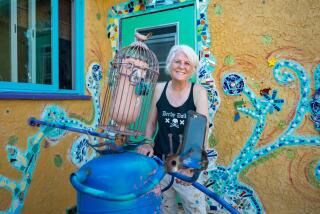SUSHI AGAIN TAKES TO THE STREETS
SAN DIEGO â Remember last yearâs âDonkey Cartâ incident? Artist David Avalos created a replica of a prop commonly used by Tijuana street photographers who peddle visual mementos for tourists. His work, however, was a mordant statement about the plight of illegal aliens.
Although Avalos had permission to install the work in the plaza at the Federal Building on Broadway, a federal judge ordered it removed to a storage area, where it was metaphorically âunder arrest.â
After its release, Avalosâ work was shown in other San Diego County sites and traveled as far as the Grand Rapids (Mich.) Museum of Art. A suit protesting the removal, initiated by the artist and Sushi gallery, Avalosâ sponsor, is pending.
The âDonkey Cartâ had been part of Sushiâs first public art project. Undaunted by last yearâs contretemps, it has launched a second. Although the international reputation of San Diegoâs premier âalternative spaceâ is based on its presentation of performance art, Sushi has been adding exhibits of âstatic art,â such as paintings, sculpture and installations.
Titled âStreetsets,â this yearâs project includes four site-specific sculptures installed downtown and an exhibit of 10 project drawings in Sushiâs lobby gallery (852 8th Ave.). All the works explore the theme of public spaces and social interaction.
âWe want to bring sculpture of artistic merit to an audience broader than the one that visits galleries and museums,â said Lynn Schuette, Sushiâs founder-director.
âOur requirement was that the works should be site-specific, that they should relate to the place where theyâre installed.
âThey are oriented toward issues confronting our society, such as border relations and the effects of the Vietnamese war. These are not just pieces to decorate public spaces.
âWe also want to stimulate dialogue about what public art can be. For example, these works, in being temporary, violate the idea of permanence.â
For the project, James Luna created âThe Artifact Piece,â an installation that documents the life of a contemporary Luiseno Indian. The piece, exhibited for ironic effect in Balboa Parkâs Museum of Man, includes artifacts that are evidence of the problems of alcoholism and violence. Others parody commercial Indian art and museum artifacts themselves.
âThe intent of the piece,â Luna said, âis to make a statement concerning the display of the American Indian as a relic that perpetuates myths about Indian peoples.â
The artist, whose works have been exhibited at the Hippodrome Gallery in Long Beach and the Centro Cultural de la Raza in Balboa Park, is a counselor in American Indian services at Palomar College.
At the Community Concourse, Michael Schnorr has erected a fence symbolizing the U.S.-Mexico border. Titled âFence Border Line Boundary,â it includes a taped sound track made at the real border with a commentary exploring the idea of a boundary line as an authentic barrier and a mythical symbol.
Schnorr, an art instructor at Southwestern College and a member of the Border Arts Workshop, has exhibited widely.
Also at the Community Concourse is Ron Williamsâ installation, which represents his experiences in Vietnam. Titled âPalace Guard,â the sandbag structure, measuring 10 by 12 feet, is surrounded by constructed oversize representations of bullets, aiming posts and sharksâ fins. Williamsâ works have been exhibited at the Patty Aande and Pawn Shop galleries.
As a team, Walter Cotten and James Skalman have created an installation titled âThe Officeâ in Sushiâs executive office. The piece, constructed to conform to the traditional office floor plan (including entrance, reception room, waiting room and inner office areas) is intended as a metaphor for a generalized social and psychological experience.
Cotten, a professor of photography and printmaking at San Diego State University, has exhibited widely. His work was included in the precedent-breaking âSan Diego Exhibitionâ at the La Jolla Museum of Contemporary Art in 1985. His partner, Skalman, an art instructor at SDSU and Grossmont College, created a room-size installation for the same landmark exhibition.
The exhibit in Sushiâs lobby includes drawings for possible public projects by Amanda Farber, Gary Ghirardi, Tom Grondona, Margaret Honda, Eduardo Lopez, Christine Oatman, David Quattrociocchi, Brent Riggs, Roberto Salas and Deborah Small.
A panel of professional San Diego artists that selected the works included David Avalos, artist-in-residence at the Centro Cultural de la Raza; Richard Baker, SDSU professor of art; Schuette, and Sushi visual art coordinator Leah Younker.
âStreetsetsâ is funded in part by a grant from the National Endowment for the Arts, the City of San Diego, COMBO and the California Arts Council, for a total of about $4,000.
The Cityâs Public Arts Advisory Board approved exhibiting the projects in the Community Concourse.
It is a point of pride for Schuette that all of the exhibiting artists received honorariums for their efforts.
âItâs time for our society to move beyond thinking that artists should work for nothing,â Schuette said.
More to Read
The biggest entertainment stories
Get our big stories about Hollywood, film, television, music, arts, culture and more right in your inbox as soon as they publish.
You may occasionally receive promotional content from the Los Angeles Times.










